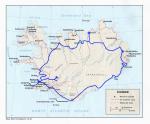We spent the majority of the last two days in China shopping. We went to the Pearl Market and again to the Silk market and managed to get some great deals (in our opinion :) on bags, shoes and watches but most importantly we got some cheap useless crap, some looked-like-a-good-idea-in-the-store-but-will-probably-not-work-at-home kind of stuff that always makes you feel good.
The Pearl Market was similar to the Silk Street market, just a bit smaller and had fewer tourists and thus was a bit cheaper. We managed to spend all our remaining Yuan (sans some dinner and ride to the airport money ;) but could easily have spend loads more.
Between the shopping we went to the Olympic park where all the main buildings constructed for the 2008 Olympics reside. The park is a vast, gray, concrete park with a few impressive highlights. First of course is the Bird’s Nest or the Beijing National Stadium – an unconventional, beautiful building that surely catches the eye. Next to the Bird’s Nest is the equally impressive Cube, especially after dark, where Phelps won eight gold medals during the Olympics. The other buildings in the park were just huge piles of concrete, steel and glass.
On Wednesday we had planned to go and see Chairman Mao in his mausoleum but we were a bit intimidated by the line and decided to come back very early Yesterday. The mausoleum opens at 08:00 in the morning and we planned to beat the crowds and arrive early on Thursday. We managed to get there around 08:15 and the line was already enormous!!! It was about three times as long as the day before. I measured the line on Google Earth and it was almost exactly one kilometer long and had about 4,000 people cuing up to see the mummy. It was probably extra long due to the long weekend around the first of May, which is especially important here in China.
This was our last chance to see the Chairman so we had no choice but to cue up. Fortunately for us the line went pretty fast and we went through the kilometer long line in about fifty minutes – not bad. After passing the extensive security check, where Elínborg was thoroughly body searched, we got into the mausoleum. Apparently they’ve had recent problems with Scandinavian blonds harassing the Chairman :)
We entered a smallish hall with a grand statue of the Chairman flanked by a great painting of a Chinese landscape. I was a bit afraid, after a few disappointments with over-hyped Chinese tourist attractions, that this was it but fortunately we exited the hall and went into another smaller one where Mr. Mao rested. We had heard that the mummy was unnaturally yellow so we were prepared for anything.
It was a bit strange that there were signs everywhere telling us to be quiet, respectful and courteous and then there were plenty of guards yelling at the people to hurry up and stay in proper lines. So many people long to pay their respect to the chairman that there isn’t a lot of time allocated to each individual and the guards have to keep the line moving.
I thought the whole experience would be creepy but when inside I just thought of how the mummy was unnaturally real and untouched – that’s all. It just seemed like chairman Mao was just sleeping peacefully under the thick red blanket embodied with the hammer and the wheat cutting instrument which English name escapes my memory right now …maybe a bit orange rather than yellow… but it wasn’t creepy at all – at least not until we got out and started processing the experience.
We were very happy that we stuck with the cue and saw the chairman and now it is one of our biggest regret of the trip not to have visited Ho Chi Minh’ in Hanoi or Uncle Ho as he is called in Vietnam.
We have now left China. It has been great three weeks and I’m sure that we’ll return some day. Thank you Yong and Amanda for welcoming us to your cities and thank you for the hospitality!
I’m sure I’ll continue to write about our trip through South-East Asia and China as I continue to digest the whole experience. This has mostly been a travel blog I’ll continue to blog on my travels – be that back home in Iceland or abroad so stay tuned!



















